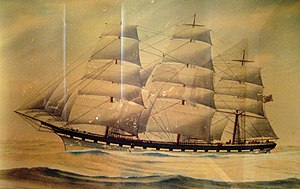City of York (barque)

City of York from an original painting given to the lighthouse keeper, David Mitchinson and his wife Kathleen by the ship's owners in appreciation for the efforts in rescuing the crew
|
|
| History | |
|---|---|
| Name: | City of York |
| Builder: | J. Elder and Company Glasgow, Scotland |
| Launched: | 1869 |
| Fate: | lost 12 July 1899 |
| General characteristics | |
| Displacement: | 1167 tons |
| Length: | 222.7 ft (67.9 m) |
| Beam: | 35.8 ft (10.9 m) |
| Draft: | 21.7 ft (6.6 m) |
| Propulsion: | three masted sail |
City of York was a 1,194 ton iron ship which sank after hitting a reef off Rottnest Island in the last few kilometres of its voyage from San Francisco to Fremantle, Western Australia in 1899.
The three masted, 68 metre (223 feet) long, iron hulled ship was built in 1869 by Glasgow shipbuilders J. Elder and Company. The British owners were the 'Ship City of York Company'. It had only just been beaten by the famous Cutty Sark in the 1885 Great Race, a race from China to London in which large profits were earned by the ship to arrive with the first tea of the year.
The vessel departed San Francisco on 13 April 1899 under Captain Phillip Jones with a cargo of 743,444 feet of Oregon timber and 3,638 doors. After making a record passage to Western Australia in just 90 days, she approached Rottnest from the north on the afternoon of 12 July 1899 in stormy weather including blinding rain and heavy seas. At that time, Wadjemup Lighthouse at the centre of the island was the single lighthouse on Rottnest. The ship was seen by the lighthouse keeper at 4:30 p.m. on a north-westerly bearing about 29 km (18 mi) off the coast of the island, heading north-east.
The keeper telephoned the news of the sighting to the head pilot who was on duty in the main island settlement at Thompson Bay who readied himself and his pilot boat to go to the assistance of the ship once it signalled for a pilot.
At 6:45, the ship had still not signalled for a pilot and the assistant lighthouse keeper challenged the ship by lighting a flare at the base of the lighthouse, meaning for the ship to stand off until the pilot had arrived.
The captain however mistook the signal for the international code as being from a pilot boat itself and that the ship should continue towards it (the pilot boat). The ship was now unwittingly sailing straight towards the shallow reefs which surround the island.
...
Wikipedia
